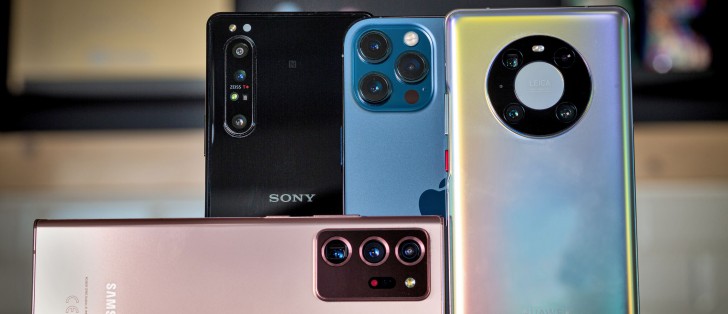Camera test: iPhone 12 Pro Max vs. Mate 40 Pro vs. Xperia 1 II vs. Galaxy Note20 Ultra

Low-light photo quality, main camera
We never doubted the phones can shoot great pictures in daylight, but shooting after dusk is more challenging. Let's see just how good are they in comparison to one another?
But first, a few words on methodology. The Galaxy Note20 Ultra and the Mate 40 Pro have dedicated Night modes that are selectable from the mode dial in the viewfinder. As such, they don't explicitly do 'night mode' processing when shooting in Photo mode, though at this point in time when multi-frame stacking is done on daylight shots and Quad Bayer/Nonacell sensors do different length exposures in principle, it's hard to tell what exactly is happening inside the phone, unless you're an engineer in one of the companies involved.
The iPhone has no separate Night mode. It has an Auto Night mode, which is used when the phone decides. You can force it on in situations below a certain light level, and you can also override the phone's decision to use it and disable it.
Meanwhile, the Xperia has no 'Night mode' per se. However, its scene detection algorithms acknowledge it's dark around and engage a 'Night scene' mode with some extra processing involved - we speculate it's a similar approach to what everyone is doing in low light outside of Night mode.
So, ultimately, we shot the test scenes twice. For the first pass, the Huawei and the Galaxy we kept in Photo mode, and we diligently disabled the Night mode on the iPhone while the Xperia was doing what it's doing.
For the second pass, we shot the scenes in Night mode on the Mate and the Note, and we let the iPhone's auto Night mode roam free. Since the Xperia doesn't have a Night mode, this second pass will be just between the other three phones.
With Night modes disabled, the Mate occasionally returns darker exposures than the other three, most pronounced in situations with warm street lighting, where it also stands out with a colder rendition than the more or less orange-leaning rest of the bunch. That, by the way, is a general rule with the Mate - when in doubt about white balance, it prefers erring on the cold side.
If we had to pick one phone for white balance and color handling in low light, it would be the iPhone 12 Pro Max. It doesn't have the Note's strong orange bias, nor the Mate's colder rendition. The iPhone gives the actual cold white sources a pleasing warming up.




Low light, main camera: Galaxy Note20 Ultra • iPhone 12 Pro Max • Mate 40 Pro • Xperia 1 II




Low light, main camera: Galaxy Note20 Ultra • iPhone 12 Pro Max • Mate 40 Pro • Xperia 1 II
The Note, meanwhile, renders cold lights colder and warm lights warmer, an exaggeration that's rarely good looking when there's a more pleasing approach for immediate comparison - otherwise not that bothersome all in itself.
The Xperia, on the other hand, is quietly good in its white balance most of the time, though it too can fall victim to the dreaded sodium-vapor lamp. Basically, if it's not the iPhone, you can expect some white balance inaccuracies.




Low light, main camera: Galaxy Note20 Ultra • iPhone 12 Pro Max • Mate 40 Pro • Xperia 1 II




Low light, main camera: Galaxy Note20 Ultra • iPhone 12 Pro Max • Mate 40 Pro • Xperia 1 II
Subtle differences in dynamic range handling can be seen, but not so much in the extremes as in the lower mid-tones, which some render brighter than others at similar exposure values. However, these are hard to attribute to one phone in particular - choices vary from scene to scene, which isn't too encouraging. You can always tap to bias the exposure towards a particular area in the frame if that specific shadow is of crucial significance.
One relatively consistent peculiarity in performance we observed on the Mate. Perhaps related to its exposure tendencies, though likely in no small part also a matter of software, it handles bright light sources like neon signs with better edge definition and notably less haloing - that's an advantage.




Low light, main camera: Galaxy Note20 Ultra • iPhone 12 Pro Max • Mate 40 Pro • Xperia 1 II




Low light, main camera: Galaxy Note20 Ultra • iPhone 12 Pro Max • Mate 40 Pro • Xperia 1 II
As for detail at 1:1 magnification, the Note maybe has an edge, but mostly insignificant one. We're pinning it to the noise-vs-detail balance and Samsung's choice to lean towards retaining grain instead of wiping it clean. The Note's shots are, indeed, noisier than the rest. That said, the Mate keeps things cleaner yet doesn't really sacrifice any detail, and it looks the closest to having your cake and eating it in these situations.
The iPhone is good at sharp contrasting edges, but not quite as detailed in finer textures - it's behind these other two. Then comes the Xperia, which is consistently softer than the rest.




Low light, main camera: Galaxy Note20 Ultra • iPhone 12 Pro Max • Mate 40 Pro • Xperia 1 II




Low light, main camera: Galaxy Note20 Ultra • iPhone 12 Pro Max • Mate 40 Pro • Xperia 1 II
In Night mode, the Mate loses the most sharpness and drops to third place in this respect. The iPhone and the Galaxy trade narrow victories for detail from one shot to another, but for practical purposes, they're very similar, Night mode against Night mode.



Low light, main camera, Night mode: Galaxy Note20 Ultra • iPhone 12 Pro Max • Mate 40 Pro



Low light, main camera, Night mode: Galaxy Note20 Ultra • iPhone 12 Pro Max • Mate 40 Pro



Low light, main camera, Night mode: Galaxy Note20 Ultra • iPhone 12 Pro Max • Mate 40 Pro
Dynamic range is roughly comparable between the three, with the iPhone slightly more prone to losing some of the highlights, the Note determined to save them, the Mate somewhere in between. As part of the highlight retention process, the Galaxy will also cancel out the halos around neon lights, something the Mate already does in Photo mode, but somehow not in Night mode. The iPhone can't be bothered, and halos are allowed in its photos.



Low light, main camera, Night mode: Galaxy Note20 Ultra • iPhone 12 Pro Max • Mate 40 Pro



Low light, main camera, Night mode: Galaxy Note20 Ultra • iPhone 12 Pro Max • Mate 40 Pro



Low light, main camera, Night mode: Galaxy Note20 Ultra • iPhone 12 Pro Max • Mate 40 Pro
Reader comments
- Hossien
- 28 Apr 2023
- cSx
No phone in the world can take pictures as well as a camera, a phone is something that is always available. The camera is not always available, but the phone is everywhere. If a random scene happens, the camera is not available to you, you have to ...
- Anonymous
- 03 May 2022
- fD9
imma tell you what, i know a thing or two about taking photos and i would take a proper camera over this
- Anonymous
- 06 Mar 2022
- Y7I
That's why I have a Sony RX100 VI for trips and outings when I want better pictures than with my phone. I can zoom in optically a lot and it has a nice picture quality. No need for a DSLR unless you are a paid photographer or need it for work or...